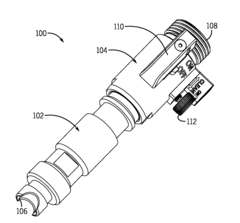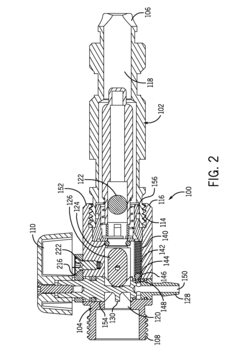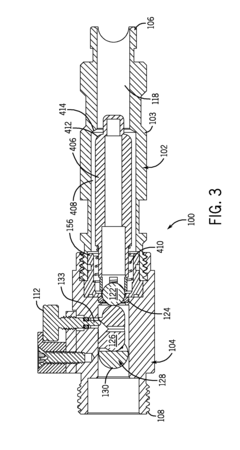Check Valves With Self-Monitoring And Predictive Maintenance Capabilities
Technology Background and Goals
Key innovations may involve integrating sensors, data analytics, and machine learning algorithms to detect anomalies, predict failures, and optimize maintenance schedules. Potential solutions could leverage IoT connectivity, cloud computing, and advanced diagnostics to provide remote monitoring, predictive insights, and actionable recommendations for maintenance interventions.
Check Valves Market Demand Analysis
- Market Size and Growth
Analyze the current and projected market size for check valves with self-monitoring and predictive maintenance capabilities. Provide estimates for different industries and regions. - Industry Demand Drivers
Identify key factors driving the demand for advanced check valves, such as regulatory requirements, safety concerns, cost savings from predictive maintenance, and industry trends towards automation and digitalization. - Application Areas
Highlight major application areas where self-monitoring and predictive maintenance capabilities for check valves are highly sought after, such as oil and gas, power generation, chemical processing, and water treatment. - Customer Segments
Categorize potential customer segments based on their specific needs and requirements for advanced check valve solutions, such as large industrial facilities, critical infrastructure, and high-risk operations. - Competitive Landscape
Analyze the competitive landscape, including major players offering similar solutions, their market share, and unique selling propositions. Identify potential gaps or unmet needs in the market.
Technology Status and Challenges
- Current Landscape
Check valves are widely used in various industries to prevent backflow. However, traditional check valves lack monitoring and predictive maintenance capabilities, leading to potential failures and unplanned downtime. - Technical Challenges
Integrating sensors and communication systems into check valves poses challenges in terms of size, power consumption, and reliability in harsh environments. Data analysis and predictive algorithms also need to be developed. - Geographic Distribution
Research and development efforts are concentrated in regions with strong industrial bases, such as North America, Europe, and Asia. Collaboration between valve manufacturers and technology companies is crucial.
Current Technical Solutions
01 Check Valve Monitoring Systems
Systems for monitoring check valve condition and performance, involving sensors to measure parameters like valve position, pressure, flow rate, or vibration to assess operational state and detect potential issues.- Check Valve Monitoring Systems: Systems for monitoring check valve condition and performance, involving sensors to measure parameters like pressure, flow rate, or vibration. Data analysis detects anomalies, enabling predictive maintenance and preventing failures.
- Predictive Maintenance for Check Valves: Techniques for predicting and scheduling check valve maintenance based on operational data and condition monitoring. Machine learning, statistical models, or rule-based systems analyze data to identify patterns indicating potential degradation or failure, allowing proactive maintenance.
- Self-Diagnostic Check Valves: Check valves with built-in diagnostic capabilities to monitor their own condition and performance. Sensors, microprocessors, or electronics assess parameters like leakage, disc position, or wear, providing real-time status updates and alerts for timely maintenance.
- Wireless Check Valve Monitoring: Wireless systems for monitoring check valve condition and performance in remote or hard-to-access locations. Wireless sensors or transmitters communicate valve data to a central monitoring station, eliminating wired connections and enabling flexible monitoring.
- Integrated Valve Monitoring and Control: Systems combining check valve monitoring with control functions for valve actuation or process control. Monitored data is used to automatically adjust valve positions, flow rates, or process parameters, enabling real-time optimization and control.
02 Predictive Maintenance for Check Valves
Techniques for predicting and scheduling check valve maintenance based on monitored condition and performance data. Data analysis, machine learning, or predictive models estimate remaining useful life and optimize maintenance schedules.Expand Specific Solutions03 Check Valve Diagnostic and Fault Detection
Systems and methods for diagnosing faults or abnormal conditions in check valves, such as leakage, sticking, or wear. Sensor data, pattern recognition algorithms, or rule-based expert systems identify and classify different types of valve faults.Expand Specific Solutions04 Self-Monitoring and Self-Diagnostic Check Valves
Check valves with integrated sensors, electronics, and software for self-monitoring and self-diagnostics. These valves can autonomously monitor their condition, detect faults or anomalies, and provide diagnostic information.Expand Specific Solutions05 Wireless Communication and Remote Monitoring
Systems and methods for wirelessly transmitting check valve condition data and enabling remote monitoring and maintenance. Wireless sensor networks, communication protocols, and cloud-based platforms for data collection, analysis, and visualization.Expand Specific Solutions
Technology Main Player Analysis
Cameron International Corp.
Robert Bosch GmbH
Key Technology Interpretation
- 提出了一种用于液体输送系统的自关止阀和检查阀的复位装置改进方案。
- 针对现有自关止阀和检查阀在液体输送系统中存在的复位问题,提出了改进方案。
- ^|可以结合预测性维护技术,对复位装置的工作状态进行实时监测和故障预警,提高系统的可用性。
Environmental Impact
Environmental impact is a crucial aspect to consider for check valves with self-monitoring and predictive maintenance capabilities. These advanced valves can contribute to sustainability by reducing emissions, conserving resources, and minimizing ecological footprint. Firstly, their enhanced reliability and efficiency help prevent leaks, thereby mitigating potential contamination risks to soil, water, and air. Secondly, their predictive maintenance features optimize maintenance cycles, reducing waste generation and resource consumption associated with unnecessary repairs or replacements. Moreover, self-monitoring capabilities enable early detection of issues, facilitating prompt corrective actions and averting environmental incidents. Overall, these innovative valves align with principles of green technology, promoting responsible industrial practices and environmental stewardship.



